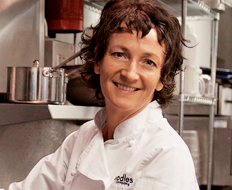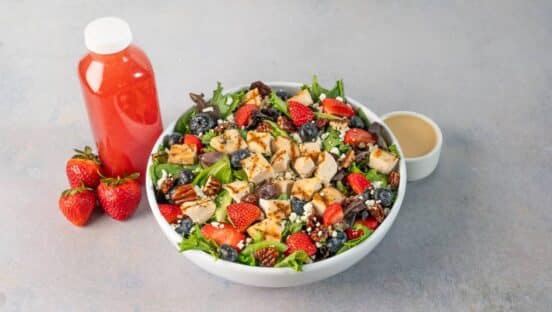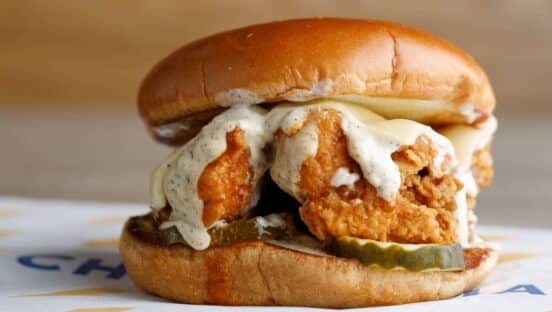Ray White has a problem. The chief foodie and head of product development for Southern California–based Veggie Grill wants to put bacon on his menu.
To the average quick-service operator, this doesn’t seem like a problem at all. But consider that Veggie Grill is an all-vegan concept offering 100 percent plant-based food. If White wants to put bacon on the menu, it has to be made of meat substitutes like tofu, seitan, or tempeh. Consider, too, that White wants the product to have the same flavor and textural profiles as regular bacon.
It’s a tall order, and one that has kept White tinkering for at least two years, so far without success.
“That’s the holy grail,” White says. “If we could do bacon, we could all buy an island out in the Pacific somewhere.”
While White’s bacon quandary isn’t exactly an industry-wide issue, his task of developing menu items that fit with the brand’s core mission and customer expectations is a regular challenge faced by R&D experts across the quick-service industry. It’s a process that can take an enormous amount of time and resources.
Many R&D chiefs, though, think they’ve boiled down the development process to a not-so-simple science. Here, a handful of those experts offer a sneak peek at their R&D process, from ideation to menu.
Step 1: Ideation
It doesn’t take a rocket scientist to figure out that bacon is good for a menu. But not every development decision is as simple as knowing which products will work and setting out to put them on the menu.
Take Taco Bell’s mega-popular Doritos Locos Taco as an example. Even if customers thought the nacho-cheese Dorito—and, later, the Cool Ranch variety—was a no-brainer in taco form, it wasn’t so obvious to Taco Bell’s culinary team until a couple of years ago.
“That was one of those ideas that someone said, ‘What if?’” says Liz Matthews, director of product development for Taco Bell. “We were in an ideation session with our partners at Frito, and someone said, ‘What if the taco shell was a nacho cheese Dorito?’ And that’s really where it started.”
That ideation session has paid off handsomely for Taco Bell; according to reports, the brand sold nearly 400 million Doritos Locos Tacos in 2012, its biggest product launch to date.
The innovation pipeline has been rich for Taco Bell in the last year. In 2012, the company also launched its Cantina Bell menu, a lineup of premium bowls and burritos developed in part by celebrity chef Lorena Garcia. Rob Lynch, vice president of marketing at Taco Bell, says that much like the origination of the Doritos Locos Taco, the impetus for all menu items is a collaborative effort involving employees in the field and at the corporate office.
“We’ve created an environment where … ideas can come from anywhere,” Lynch says. “Really all it takes is someone in the organization who has an idea, sends it to my consumer insights team, simply … an e-mail that says ‘Hey, what do you think about this?’” He says Taco Bell gets about 100 ideas every month. Those that rise to the top are fleshed out so the culinary team can figure out how each idea might fit customer expectations and needs, he says.
For other brands, the ideation process is achieved on a smaller scale. Bruegger’s executive chef Philip Smith says he regularly researches restaurant industry trends, including in the fine-dining and casual-dining sectors, to understand which ingredients and flavors are resonating with consumers. The challenge, he says, is coming up with ideas that are innovative but maximize existing Bruegger’s ingredients and procedures, while also aligning with customer expectations.
“It’s balancing, on any given day, what it is that’s our core, what we’re credible for, what our guests expect from us, and at the same time reconciling all of the trend information [and] seasonal information,” Smith says. “Are we trying to drive sales from new ingredients? Are we trying to drive repetition?”
Others find that getting into the field is the best way to get a taste of what’s possible in the restaurant industry. Veggie Grill’s White says he regularly visits other Los Angeles restaurants to get a handle on food trends. Similarly, Ric Scicchitano, senior vice president of food and beverage for Corner Bakery, travels to restaurants and trade shows around the U.S. to see first-hand which trends are influencing fellow operators.
Corner Bakery’s culinary strategy committee made up of Scicchitano, C-suite executives, and a franchising representative meets quarterly to help Scicchitano and his team funnel the ideas they collect into viable Corner Bakery menu items.
“We start talking about what could be, what couldn’t be, what’s feasible, what’s not feasible,” he says, noting that the committee is planning as far ahead as one or two years for new products. “At this stage, it’s really important to realize that the feasibility filter is very rough, it’s very crude. There isn’t an up or down vote.”
At least, not yet.
Step 2: Development
To support its strong lunch business, Corner Bakery has a deep line of premium sandwiches, from the Chicken Pesto on Ciabatta Ficelle to the Poblano Fresco on Poblano Cheese Bread and the D.C. Chicken Salad on Steakhouse Rye.
Chances are, each of them survived a cutthroat testing process and outlasted other possible sandwich opportunities to find its way to the menuboard.
“I always tell everybody, you get in the Hall of Fame for batting .300,” Scicchitano says. “So if we go out there with 10 items, I don’t expect all 10 of them to work. If we’re going to test sandwiches, I’m going to have four, five, or six sandwiches out there, so I’m going to find out the ones that guests like, that really rise to the top. … With all of the effort you put out there, you have to have a higher chance of success.”
Perhaps it’s no surprise that Scicchitano and his team can come up with so many options; the kitchen is where chefs come alive, and quick-service chefs are not so different from fine-dining chefs. Many of them graduate from culinary academies, and some have even run their own restaurants before finding their way to the fast food world.
Bruegger’s Smith says this is a real advantage for quick-service companies.
“If you want to take someone like a quick serve or some more narrowly defined concept forward, it’s hard to do that with someone who’s come from a less-evolved concept,” he says. “If you come from a more full-service background, you at least have this portfolio of ideas in your head, so you understand flavors and appeal. Then you can take them and make them work within a system.”
Like Scicchitano, Smith says he develops several menu options before whittling the list down to a few to present to the company’s leadership team. He says he’s constantly considering the restaurant’s existing pantry list, and will visit the Bruegger’s next door to the company’s headquarters to consult with that restaurant’s general manager.
“I’ve got to make it work for the system,” he says. “My job is not to try to throw the operation into fits and starts. It’s to make things work for them, but at the same time bring new culinary excitement so there are new and existing things out there.”
Figuring out how to do that can take time. The Doritos Locos Taco went through several iterations and took about two years to develop, Matthews says, but it was mostly because the culinary team knew the product had nearly no room for error.
[pagebreak]
“If you think about the Taco Bell consumer and how much they love Taco Bell, and you think about Doritos lovers and how much they love that brand, if you don’t get it right, they call you out,” she says.
Lucky for Matthews, the Taco Bell test kitchen is flush with resources for successful product development. She says the entire second floor of Taco Bell’s headquarters is committed to food, and includes laboratories for sensory analysis, kitchens for both food and beverage testing, and four different areas designed to reflect actual Taco Bell restaurants. The culinary team has about 40 dedicated employees.
Tessa Stamper’s development team isn’t quite that big. But the registered dietician and head chef at Noodles & Co. does have a test kitchen at headquarters with all of the same equipment as the average Noodles kitchen, where she says she and her team will plow through “countless iterations” of possible new menu items.
“We will start out with some dishes and flavor profiles and go through sort of a process of elimination, if you will, with some of our dishes that ultimately our guests are going to have to really like,” Stamper says. “But they also have to fit this broader puzzle, and the pieces of that puzzle include things like our throughput requirements, our equipment capabilities, our team member ability to execute the dishes we come up with, making sure supply chain is able to source ingredients that we want. If any of those pieces of the puzzle don’t fit together, the dish won’t work.”
Of course, the food also has to taste good.
Step 3: Testing
It would be an understatement to say Veggie Grill items have to be vetted before landing on the permanent menu at each of the company’s 19 units. White says that once he’s satisfied with a product, it goes through the CEO, operating partners, board of advisers, C-suite, and focus group before it can be approved as a an addition to the menu.
“We have what we call the ‘80/20 Rule,’” White says. “We’ve learned over the last seven years that you just can’t take things on and off the menu just because you think you need to put something else on. It creates such a firestorm. … Our 80/20 Rule is we go to the focus group, [and] if 80 percent of them say yeah, we like it, then that can be a menu change for us. Then usually we pick two different restaurants in kind of diverse areas, and we run it for about a month and try it.”
If at any point a dish fails the 80/20 Rule, he says, it’s back to the drawing board, where he might tweak the dish or start over completely.
Smith also consults with his executive team before proceeding further into tests with new menu items.
“We have a long, stainless steel bench, and our leadership team will stand around, and … we’ll start with ideas, and then we’ll narrow them down,” Smith says. “[I say,] ‘Here are the salads I recommend doing for the summer, and this is how they build, and these are the ingredients they need, and here are the nutritionals, and here are the costs, and these are the implications, and can I take it to test?’”
At Corner Bakery, Scicchitano works with his marketing department to bring in potential consumers to help verify new products his team has been working on. He says they funnel people in and out, testing things like flavor profiles and spice levels. This process doesn’t just give him valuable consumer insights, but it also helps keep the culinary team grounded. A few years ago, he says, the company wanted to do “big-boy, adult mac and cheese,” with Brie, Smoked Gouda, and blue cheeses. When the test group responded negatively, Scicchitano tried again with common cheeses like Cheddar. The test group loved it.
“So the consumers right there in front of us in the test kitchen said, ‘Yeah, these are gourmet things you’re working on, but you’ve got to deliver on something that’s basic and comforting,’” he says.
Other brands filter their new product development through operating partners and franchisees. Taco Bell has a committed section of its test kitchen where it brings in franchisees and gathers feedback on process. Noodles & Co. similarly has a direct line of communication open with its operators.
“Once a dish is out in the field for certain, we get a lot of feedback from them about how to improve the dish or make it easier from an operational perspective,” Stamper says. “But our managers and folks are out in the field … they’re out there every day with the guests, and they hear a lot more than I hear when I’m here in my test kitchen. So we encourage them to give us as much feedback as possible on what guests are asking for.”
Once approved internally, nearly every new quick-service product is issued to a test market before it can be approved for a system-wide roll out. All experts interviewed for this story say they look for markets that represent a cross-section of consumers in different parts of the country, if possible.
For Taco Bell, this helps assuage any doubts about riskier menu propositions, like its Cantina Bell menu.
“We tested that, we validated, we worked with our agency partners to create the advertising that would bring it to life,” says Taco Bell’s Lynch. “Our model is, we go into a test market and buy up the local media, we put the products into those restaurants, we put the [point-of-purchase materials] up in those stores, we listen to what our customers tell us.”
Step 4: Menu
The craziest turnaround Noodles & Co. ever made with a new menu item, Stamper says, was about 48 hours. The company was launching a new fruit salad, and on the eve of its roll out, operators reported back to corporate that its strawberries weren’t up to snuff. So the culinary team found a Fuji apple replacement, recorded preparation directions with an iPhone, and made the switch.
“You have to be quite nimble in your development,” Stamper says. “It really depends on the item. We recently just added a naturally raised, slow-braised pork to our menu. It’s the first time that we’ve had pork on the menu, and that development time frame took a long time because we had not only a flavor and texture profile that we’re looking for, but we wanted to source it naturally raised. So that took well over a year.”
Most product development takes closer to a year than 48 hours, the R&D chiefs report. Smith says Bruegger’s development process can take about six months; at Corner Bakery, Scicchitano says, it takes about 13–21 weeks to get something from the test kitchen to the menu.
But the development process can be ongoing. For example, Scicchitano says Corner Bakery is about to take a signature product off the menu to retool it. And Lynch says Taco Bell will continue to develop around the foundations established by the Doritos Locos Taco and the Cantina Bell menu.
“We’ve got a whole pipeline of [Doritos Locos Taco] flavors that we’re continuing to explore and validate,” he says. “The ideas continue to live and breathe.”
Perhaps the best news for chefs across the quick-service industry is that Americans’ palates are maturing; customers are getting more adventurous. While it might not make the development process any easier, it should at least make it a little bit more creative.
“The openness is starting, and with that, people are open to trying new things and new culinary adventures,” says Veggie Grill’s White. “But again, it still comes back to the same thing: You’ve got to have good flavor, you’ve got to have good food. It doesn’t matter what you’re doing; if you don’t have good food, it’s not going to work.”











